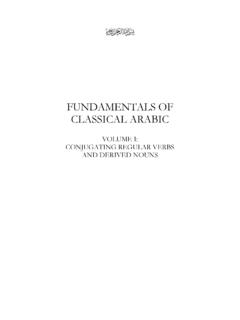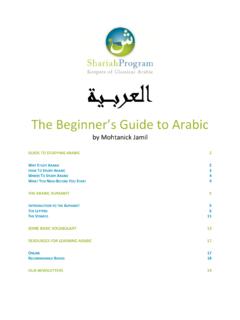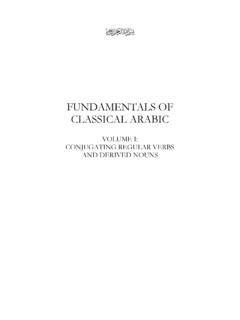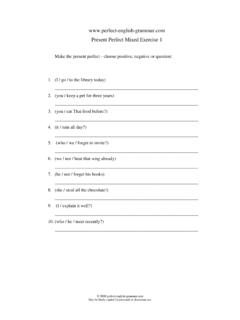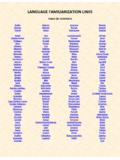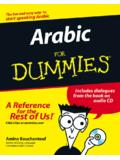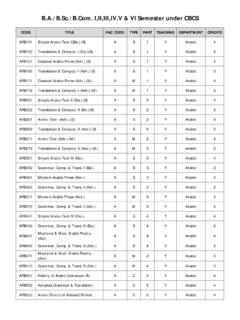Transcription of Gujarati Script Grammar - Indian Language Technology ...
1 1 Script Grammar FOR Gujarati Language Prepared by Technology Development for Indian Languages (TDIL) Programme Department of Information Technology , Government of India in association with Centre for Development of Advanced Computing (C+DAC) 2 Table of Contents 0. INTRODUCTION .. 3 1. OBJECTIVES OF Script Grammar .. 4 2. END USERS FOR Script Grammar .. 5 3. SCOPE .. 6 4. TERMINOLOGY .. 7 5. PHILOSOPHY AND UNDERLYING 11 6. Script Grammar STRUCTURE .. 12 PERIPHERAL ELEMENTS OF THE Script Grammar .. 13 CONFORMITY TO THE SYLLABLE STRUCTURE .. 14 Script Grammar PROPER .. 18 The Character Set of Gujarati .. 18 Consonant M tr Combinations.. 24 The Ligature Set of Gujarati .. 30 The Collation Order of Gujarati .. 35 7. REFERENCES .. 37 8. ANNEXURES .. 38 Annexure 1: Names of experts who have contributed to the Script Grammar .. 38 Annexure 2: Unicode Table of Gujarati .. 39 3 0.
2 INTRODUCTION The term Script Grammar refers to the behaviour pattern of the writing system of a given Language . Languages which have written representations do not use a haphazard manner of storing the information within the system, but use a coherent pattern which is similar to the linguistic Grammar of a given Language . With the help of specialists (not necessarily linguist) who work in the area of the written representation of the Language , the manner in which the shapes of the characters of the Language and the representation of the conjunct forms is provided. In other words the Script Grammar deals with the surface structure of the Language and tries to provide the best possible fit for shapes and their representation. Since this is a highly subjective issue, the shapes provided here are recommendations at the best and conform to the perception of the mandating body/evaluators who consensually arrive at the best possible fit which is acceptable to a majority of users.
3 An example from the Devan gar Script will make the above clear. Although Marathi and Nepali share the same Script Devan gar , not only do they not share the same character inventory but in addition the representation of certain characters is different. Thus the Nepali /la/ is different from the Marathi /la/ in so far as the placement of the stem is concerned Nepali Marathi . This ensures that the Script Grammar conforms to the Language in question and provides the character shapes acceptable to a given user community. It should be noted that this does not mean monotony. The Marathi and Nepali /la/ can have a variety of forms once the intrinsic structure of the character is determined. Script Grammar is the term used to define: the writing system used to inscribe a given Language the history of the Script and Language (wherever available) the syllabic structure of the writing system of the Language the rule ordering of the characters within the syllable (akshar) description of the syllabic clusters collation order of the characters: lexical / dictionary sorting order 4 1.
4 OBJECTIVES OF Script Grammar The Objectives of the Script Grammar for each Language can be divided into two major parts: Societal: Provide a visual representation of shapes that are deemed to be in conformity with the perception of a given community Ensure thereby that this perception is safeGguarded Through wideGspread dissemination and creation of appropriate tools ensure that within the given linguistic community, all media tries to adopt the given shape. Technical: Classify the Language in terms of its ISO and also whether it belongs to the Abjad, Akshar (Alphasyllabary) class. Provide an inventory of the characters pertinent to the Language and classify the same in terms of their taxonomy. As a corollary determine whether the inventory is in conformity to the Syllable formalism as stipulated in ISCII 91 and subsequently adopted by Unicode. Since Brahmi is written from left to right, and since certain characters do not follow the linear L to R order, provide an inventory of displaced catenators characters such as M tr s that concatenate to the Consonant Propose the best shape representation of the individual characters as well as of the ligatures used within a given Script .
5 As a corollary request the expert(s) to identify the largest possible strings of such ligatures. Finally provide the collation order pertinent to that Script / Language , which would be of great utility to highGend NLP as well as to CLDR s in the pertinent Language . Thus for example, the collation order for Marathi is different from Hindi although both languages share the same Script . Thus in Marathi , are placed at the end of the consonant inventory after in the sort order. In Hindi is sorted along with and with 5 2. END USERS FOR Script Grammar The scriptGgrammar specific to a given Language can be used by a large number of users. Most importantly it can be used by font developers desirous of developing a font which is compliant with the perception of the characters and ligatures of a Language by its user community. Certain features of the Script Grammar such as the shapes can also be used for testing OCR and OHWR.
6 Similarly information regarding Ligatures as well as collation order can help in highGend NLP work such as detecting invalid combinations, correct implementation of syllable structure, prediction routines to name a few. Information regarding collation and character sets can be also used for CLDR. They allow the font designer to design a font which is in compliance with the norms and standards of that particular Script . A major problem which will be dealt with in the template is one of ligatures. The final list of ligatures defined by the Script Grammar allows the font designer to write specific rules for such glyphs. It permits the software developer to design and implement the keyboard and the input mechanism which will meet the requirement of the particular linguistic community. The collation or sort order as described in a Script Grammar permits the software developer to write software functions/ routines for sorting data in all applications.
7 Script Grammars are equally important for keyboard design, especially when supplemented by frequency data from a corpus. As can be seen the Script Grammar has a wide range of use and can be of utility to font developers, Indian Language developers and linguists in the area of computation. 6 3. SCOPE This Script Grammar document contains following information about the Language and the Script used for writing the Language . 1. Name of the Language and its representation in the 3 letter mnemonic as per ISO standard. 2. Script used to inscribe the given Language 3. The structure of the Script used for writing the Language Rule ordering of the characters within the syllable formation is a Language Description of the syllabic clusters of the Script Collation order of the characters: lexical / dictionary sorting order Compliance of the Script with Unicode. These will be treated within the relevant sections of the Script Grammar 7 4.
8 TERMINOLOGY1 Abjad: A writing system in which each symbol always or usually stands for a consonant. The long vowels are indicated. However the short vowels are rarely marked and the reader needs to supply these. Example: Urdu written in PersoGArabic Script is an example of this writing system. Abugida: also called an alphasyllabary, is a segmental writing system in which consonant vowel sequences are written as a unit: each unit is based on a consonant letter, and vowel notation is obligatory but secondary2 Akshar: see Abugida Allographs: Variants of the representation of a character. Thus ae and [U+00E6] in Latin alphabet are allographs. Allo+ Script : The term relates to languages which share a common Script . Thus Devan gar is used to write 9 official languages. However these languages do not use the same set of characters. Thus Marathi uses the retroflex lla [U+ 0933] which Hindi does not use. Flaps used in Hindi [U+095C] [U+095D] are not used in Marathi.
9 These subGsets of scripts based on a single matricial Script are termed as alloGscripts. Alphabet: A set of letters used in writing a Language . Example: The English Alphabet. Aspirated consonant: A consonant which is pronounced with an extra puff of air coming out at the time of release of the oral obstruction. This has a sound of an extra "h". Basic alphabet: The minimal set of letters which can be used for uniquely encoding every word of a Language . The basic alphabet for English consists of only the upperGcase letters AGZ Catenators: Also termed as Concatenators are characters which are concatenated to another character. In the Brahmi Script these are the M tr s or Vowel modifiers which are adjoined to the consonant and add a vocalic value to the consonant. Conjunct: The Indic scripts are noted for a large number of consonant conjunct forms that serve as orthographic abbreviations (ligatures) of two or more adjacent letterforms.
10 This abbreviation takes place only in the context of a consonant cluster. Under normal circumstances, a consonant cluster is depicted with a conjunct glyph if such a glyph is available in the current font. In the absence of a conjunct glyph, the one or more dead 1 As in the case of the BIS Document, in order to make the terminology accessible for all readers, examples have been chosen from English/Latin scripts, wherever possible. Some definitions have been excerpted from the BIS ISCII91 document and suitably modified where necessary. 2 Wikipedia definition 8 consonants that form part of the cluster are depicted using halfGform glyphs. In the absence of halfGform glyphs, the dead consonants are depicted using the nominal consonant forms combined with visible virama Consonant: A letter representing a speech sound in which the breath is at least partly obstructed. Diacritic:A mark added to a letter which distinguishes it from the same letter without a mark, usually having a different phonetic value or stress.
